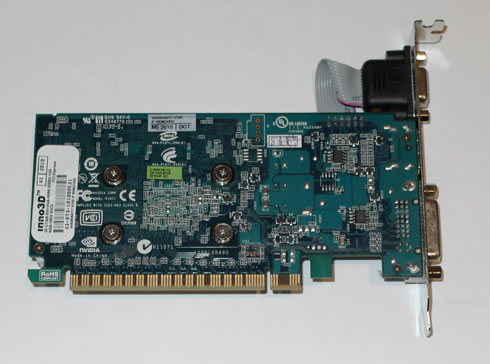1. Meet the Inno3D GT430
The Nvidia GeForce GT 430 is the first mainstream Fermi GPU for the PC using the same Fermi architecture in the GTS 450, GTX 460, GTX470 and GTX 480. The Fermi architecture was designed to run next generation DX11 titles and Blu-Ray 3D.
The GeForce GT 430 is considered as the replacement of the GTS 240 GPU. Its 40nm GPU is clocked at 700MHz, comes with 96 Cuda cores 2GB DDR3 memory running at 1800 Mhz and a 128-bit memory interface. The result is a memory bandwidth of 28.8 GB/sec and a Texture Fill Rate of 5.6 billion/sec.
GeForce GT 430 is specifically designed to power today's digital media PCs, providing enough power for photo and video editing, Blu-ray 3D, mainstream gaming, and the next generation of GPU-accelerated Web browsers. The card also supports CUDA Technology, PhysX technology and comes equipped with an HDMI 1.4 output.
NVIDIA believes that they’ve made the ultimate HTPC card, and that’s the line they’re going to be using to sell it. However, the company claims that it could also be used for gaming. Specifically, compared to the GT240, the new GT430 scores approximately 1200 points higher in the Vantage (Pro ) benchmark and also is more powerful in popular games such as "Crysis" and "Lost Planet," according to the company.
Below you see a comparison among the GT 430 with some other Fermi -based solutions. Fermi series. Looking at the specs, we can easily understand that the GT 430 series are a replacement of the GT 240. At $80, the GT 430 also goes directly up against the Radeon HD 5570 (DDR3 & GDDR5) and the Radeon 5670. However, all of these cards are faster in gaming performance, and that's why NVIDIA has chosen to presents the GT 430 as the optimum HTPC performer. But let's wait to see some benchmark figures first before drawing any conclusions.
| |
GeForce GT 430 |
GeForce GTS 450 |
GeForce GTX 460 |
| Stream (Shader) Processors |
96 |
192 |
336 |
| Core Clock (MHz) |
700 |
783 |
675 |
| Shader Clock (MHz) |
1400 |
1566 |
1350 |
| Memory Clock (datarate MHz) |
3600 |
3608 |
3600 |
| Memory amount |
1024MB |
1024MB |
768~1024MB |
| Memory Interface |
128-bit |
128-bit |
192~256-bit |
| Memory Type |
gDDR5 |
gDDR5 |
gDDR5 |
Meet the Inno3D GT430
Today we will present the Inno3D GeForce GT 430 graphics card.

Specifications:
- CUDA cores 96
- Graphics Clock (MHz) 700
- Processor Clock (MHz) 1400MHz
- Memory Clock (MHz) 1800MHz
- Max Memory Amount 2GB DDR3
- Memory Interface 128 bit
- Memory Bandwidth (GB/sec) 28.8
- Texture Fill Rate (billion/sec) 5.6
The Inno3D GT 430 retails in the following small package:

The bundle includes just ROM discs with drivers and not any cables. The half-height single- slot card is equipped with a small heatsink:


DVI-D, D-Sub and of course HDMI v1.4 ports are provided. The card is powered by the PCI-e slot so there is no need for any external power:

Below you see the card's basic specifications.The GPU core runs
at 700MHz, the memory at 900MHz and the Shaders at 1400MHz. The Inno3D GT 430 runs at stock speeds leaving us with some hopes that it could be easily overclocked:

2. Test platform
- Setup
Here is our test PC setup:
- Motherboard: Asus Stiker II Extreme Bios 1403 (Nvidia 790i Ultra SLI)
- Processor: Intel Q9300
- Case: Open Air testbed
- Power Supply: OCZ GameXStream GXS600 SLI-Ready
- Memory: 2x1GB Supertalent DDR3-1600 (1333MHz@ 7-7-7-20-1T)
- HDD: WD 200JB 7200RPM
- Monitor: LG L246WH-BH 24"
- Windows VISTA SP2 32bit with all the latest updates installed
- Latest DirectX libraries
- Nvidia v260.89 with High Quality settings
Many games and applications were used in order to measure the performance (FPS) of each card.
DirectX 9
- 3DMark 05 v1.30
- 3DMark 06 v1.20
- Crysis WarHead v1.00 Retail
- Far Cry 2 v1.02 retail
- Lost Planet 2 Benchmark
DirectX10
- 3DMark Vantage v1.02
- Company Of Heroes v1.7.1
- Crysis WarHead v1.00 retail
- Far Cry 2 v1.00 retail
- Left4Dead v1.00 retail
- Urigine Heaven Benchmark v2.00
- StreetFighter IV Benchmark v1.00
- Stalker: Call Of The Pripyat Benchmark v1.00
DirectX11
- Dirt 2 v1.01 retail
- Alien Vs Predator Benchmark v1.03
- Lost Planet 2 Benchmark
- Testbed DirectX9
For all the tests we used the default settings for 3DMark05 as you see below:

Again we left all the settings to default:

- Testbed DirectX10
We used the three built- in benchmarks to test the performance of each graphics card. We measured the performances at various resolutions using the "Performance" and up to the "Extreme" settings.

We used the built in benchmark with all the details maxed out.

We used the FRAMEBuffer benchmark tool for the resolutions of 1280x1024, 1680x1050 and finally 1920x1200. We used all the possible quality levels to get an idea what the graphic card can do at each corresponding resolution.
We used the built-in benchmarking utility and maxed out all visual details, under both DX9/DX10 and settings up to 16x AA/16x AF.
